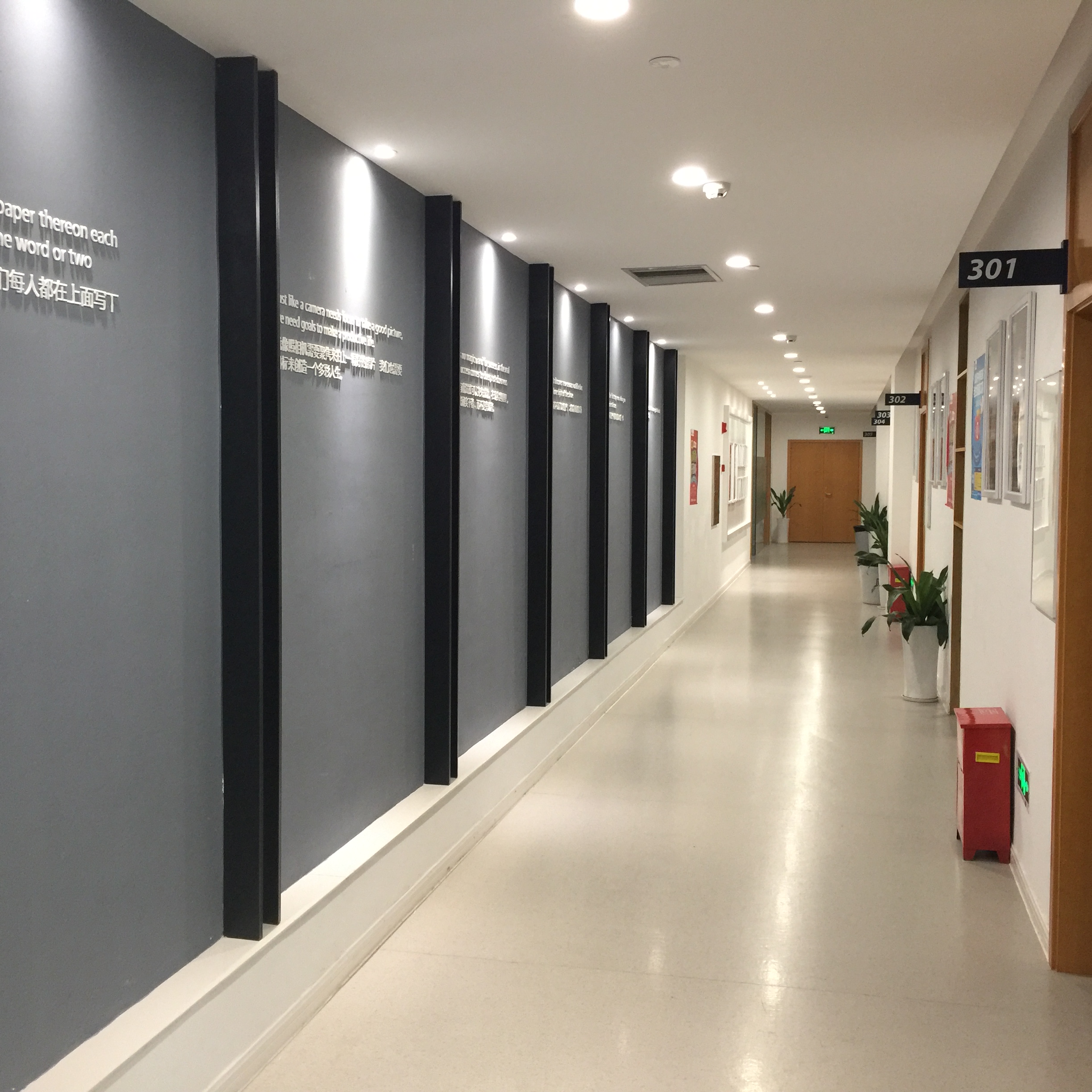Questions 12-22 are based on the following passage.
Dong Kingman: Painter of Cities
A 1954 documentary about renowned watercolor painter Dong Kingman shows the artist sitting on a stool on Mott Street in New York City's Chinatown. A crowd of admiring spectators [Q12] watched as Kingman squeezes dollops of paint from several tubes into a tin watercolor [Q13] box, from just a few primary colors, Kingman creates dozens of beautiful hues as he layers the translucent paint onto the paper on his easel. Each stroke of the brush and dab of the sponge transforms thinly sketched outlines into buildings, shop signs, and streetlamps. The street scene Kingman begins composing in this short film is very much in keeping with the urban landscapes for which he is best known.
Kingman was keenly interested in landscape painting from an early age. In Hong Kong, where Kingman completed his schooling, teachers at that time customarily assigned students a formal "school name." His interest was so keen, in fACT, that he was named after it. The young boy who had been Dong Moy Shu became Dong Kingman. The name Kingman was selected for its two [Q14] parts, "king" and "man"; Cantonese for "scenery" and "composition." As Kingman developed as a painter, his works were often compared to [Q15] paintings by Chinese landscape artists dating back to C E 960, a time when a strong tradition of landscape painting emerged in Chinese art. Kingman, however, [Q16] vacated from that tradition in a number of ways, most notably in that he chose to focus not on natural landscapes, such as mountains and rivers, but on cities. [Q17]
[Q18] His fine brushwork conveys detailed street-level ACTivity: a peanut vendor pushing his cart on the sidewalk, a pigeon pecking for crumbs around a fire [Q19] hydrant, an old man tending to a baby outside a doorway. His broader brush strokes and sponge-painted shapes create majestic city skylines, with skyscrapers towering in the background, bridges connecting neighborhoods on either side of a river, and [Q20] delicately painted creatures, such as a tiny, barely visible cat prowling in the bushes of a park. To art critics and fans alike, these city scenes represent the innovative spirit of twentieth-century urban Modernism.
During his career, Kingman exhibited his work [Q21] internationally. He garnered much acclaim. In 1936, a critic described one of Kingman's solo exhibits as "twenty of the freshest, most SATisfying watercolors that have been seen hereabouts in many a day." [Q22]
Question 12.
A. NO CHANGE (watched)
B. had watched
C. would watch
D. watches
答案:D
难度系数:Easy
本题考察动词时态,属于常规知识考点。全段动词都是采用的一般现在时,因此,为了保持时态的一致性,此处动词也应该用一般现在时。
Question 13.
A. NO CHANGE (box, from just a few primary colors,)
B. box. From just a few primary colors,
C. box from just a few primary colors,
D. box, from just a few primary colors
答案:B
难度系数:Medium.
本题考查"run-on"句型。两个完整的句子之间不能仅仅用逗号连接,如若原文的错误在于用逗号连接两个完整的句子,一般我们要求把逗号改成分号或句号,亦或是在两个句子之间加上个合适的连词。
该题主要针对本段第二句和第三句的衔接进行考察,我们先忽介词短语 "from just a few primary colors" ,就可以清晰地看到前面第二句有自己独立的主谓宾: " A crowd of admiring spectators watches as...", 第三句同样也是结构完整的句子:"Kingman creates...", 两个结构完整的句子,中间没有分号或句号隔断,也没有连词连接,是典型的"run-on"句型。正确答案B将前后两个句子用句号分开,避免了这种错误句型的产生。
Question 14.
A. NO CHANGE (parts, "king" and "man";)
B. parts: "king" and "man,"
C. parts "king" and "man";
D. parts; "king" and "man"
答案:B
难度系数:hard
本题考察标点符号。对于标点符号,尤其是分号和冒号的考察,在现行的SAT语法题中有少量出现过,新题型沿用了这一考点,并加大了考察力度,因此我们应该引起足够的重视。
该题中,"king" and "man"是对于two parts的解释,因此两者之间应选用冒号连接,表示解释说明。A选项中逗号起不到解释说明的作用,而且"king" and "man"后的分号将后面的短语Cantonese for "scenery" and "composition." 分隔成了单独存在的成分,不合适。同理C也可以排除。D选项two parts和"king" and "man"之间用的是分号,分号一般用来连接两个独立分句,起不到解释说明的作用,故而选择B选项。
Question 15.
A. NO CHANGE (paintings by Chinese landscape artists)
B. Chinese landscape artists
C. painters of Chinese landscapes
D. Artists
答案:A
难度:Medium
本题考查同类比较,是现行SAT语法中的常规考点。做这种题时需要观察两个比较对象是否具有可比性。我们只能将画家与其他画家进行比较,将作品与其他作品进行比较,切不可将画家与画家的作品进行比较。前文中的被比较对象是"his works", 因此后文中的被比较对象也只能是画作"paintings",BCD均是画家,不可取。
Question 16.
A. NO CHANGE (vacated)
B. evacuated
C. departed
D. Retired
答案:C
难度系数:Hard
本题考查词义。在现行的语法题中,对于词汇意义及用法的考察一直都是难点,新题型没有放弃对于这一考点的考察,反而有加大考察力度的趋势。这种题没有技巧性可言,只能稳扎稳打从词义角度出发做题。原文想表达的意思是kingman不像其他人一样致力于自然风景的创作,而是专注于城市景观的描绘,他是背离了传统的。因此选用"departed"最合适,它有离开,背离的意思。A选项vacated意为腾出,空出;B选项意为疏散,D选项意为退休,均不合适。
Question 17. To make this paragraph most logical, sentence 3 should be placed
A. where it is now.
B. before sentence 1.
C. after sentence 1.
D. after sentence 4.
答案:C
难度系数:easy
本题考察文章内部的连贯性,与现行SAT语法中的IP题颇为相似。做这种题时我们需要回到原文中,将选项所提供的解决方案一一代入,看哪个最合适。我们一起来看原文中的这三个句子:"(1)Kingman was keenly interested in landscape painting from an early age. (2)In Hong Kong, where Kingman completed his schooling, teachers at that time customarily assigned students a formal "school name." (3)His interest was so keen, in fACT, that he was named after it. The young boy who had been Dong Moy Shu became Dong Kingman." 第三句中的His interest was so keen that与第一句中的kingman was keenly interested in形成呼应,理应放在第一句之后,来衔接第一句。然后再举第二句中的例子来印证第三句中的he was named after it. 因此1,3,2这样的句序最佳。
Question 18. Which choice most effectively establishes the main topic of the paragraph?
A. Kingman is considered a pioneer of the California Style school of painting.
B. Although cities were his main subject, Kingman did occasionally paint natural landscapes.
C. In his urban landscapes, Kingman captures the vibrancy of crowded cities.
D. In 1929 Kingman moved to Oakland, California, where he attended the Fox Art School.
Question 19.
A. NO CHANGE (hydrant,)
B. hydrant—
C. hydrant:
D. hydrant
Question 20. The writer wants to complete the sentence with a third example of a detail Kingman uses to create his majestic city skylines. Which choice best accomplishes this goal?
A. NO CHANGE (delicately painted creatures, such as a tiny, barely visible cat prowling in the bushes of a park.)
B. exquisitely lettered street and storefront signs.
C. other details that help define Kingman's urban landscapes.
D. enormous ships docking at busy urban ports.
Question 21. Which choice most effectively combines the sentences at the underlined portion?
A. internationally, and Kingman also garnered
B. internationally; from exhibiting, he garnered
C. internationally but garnered
D. internationally, garnering
Question22. The writer wants to conclude the passage with a sentence that emphasizes an enduring legacy of Kingman's work. Which choice would best accomplish this goal?
A. Although Kingman's work might not be as famous as that of some other watercolor painters, such as Georgia O'Keeffe and Edward Hopper, it is well regarded by many people.
B. Since Kingman's death in 2000, museums across the United States and in China have continued to ensure that his now iconic landscapes remain available for the public to enjoy.
C. The urban landscapes depicted in Kingman's body of work are a testament to aptness of the name chosen for Kingman when he was just a boy.
D. Kingman's work was but one example of a long-lasting tradition refreshed by an innovative artist with a new perspective.





















 京公网安备11010802021790号
京公网安备11010802021790号









 学习资料
学习资料
